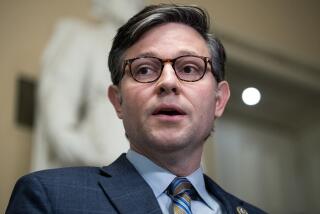Catastrophic-Illness Legislation Is a Catastrophe for the Young
- Share via
The catastrophic-health-care legislation being considered by Congress will, I suggest, merely trade one catastrophe for another. In the name of helping the elderly, we will create another program that will burden our children and throw more money into the bottomless pit of high-technology medicine.
Medicare is already projected to explode 60% in four years, from $74 billion in 1985 to $120 billion in 1989. Much of this money is spent on heroic medicine for people with no hope of recovery. Thousands of times a day in hospitals across the country, heroic medicine brings someone back to life from a terminal illness, and large amounts of taxpayers’ money are spent so that he or she can die again tomorrow. We are already spending too much of our finite medical resources in attempting the impossible. Do we really want to fund a program that will give heart transplants to 75-year-old former smokers while we as a nation are cutting back well-baby clinics and preventive health care?
We refuse to even discuss the reality that in an aging society, with exploding numbers of elderly and exponentially rising health-care costs and myriad other unmet needs, the level of treatment for a 90-year-old might be different from that for a 9-year-old. Should we not put our limited dollars into more quality of a healthy life rather than more quantity of a sick life--more to the recoverable young rather than the terminally ill? Will not this program for catastrophic-illness coverage reallocate additional health-care dollars to those who have most of their years behind them, at the expense of those who have most of their years ahead of them? Is this fair?
America doesn’t have a health-care system; we have an uncoordinated collection of health programs that once seemed like a good idea. There is no one trying to weigh how the money that we propose to spend could be used to buy more health elsewhere. There is no sense, or even a realization, of trade-offs in American medicine; 35 million Americans don’t have full access to even basic health care, only 40% of Americans below the poverty line are covered by Medicaid, and yet we propose a new expensive program for the elderly that everyone knows will have only marginal returns. Should not the acute needs of the young be a higher priority than the chronic needs of the elderly? Everyone admits that the elderly have unmet needs, but should we not weigh these against other unmet needs?
The new proposal will also dramatize the major weakness of U.S. medicine: It has no sense of limits; “can do” has become “must do.” Vast resources that could be used far more effectively elsewhere are poured into hopeless cases. There are at least 10,000 comatose, vegetative people existing on life-support systems with no real hope of recovery. Neither American society nor American medicine has maturely come to grips with the subject of death. Death to American high-tech medicine is not part of life’s cycle, but something to be defeated no matter what the cost.
We are not wise enough to use the machines that we were smart enough to invent. Machines sustain bodily functions long after any meaningful life has gone. Give another open-ended program to health providers, and we shall soon have large numbers of Kafka-like Medicare warehouses where machines keep corpses alive while we simultaneously are forced as a society to shut down well-baby clinics and illness-prevention programs.
Dietrich Bonhoeffer, the German theologian, warned that “the ultimate question for a responsible man is . . . how the coming generation will live.” With unthinking (though well-meaning) programs that will spend massive resources on unnaturally prolonging the lives of the elderly, we are misusing resources that could naturally save and improve the lives of far more Americans of all ages. We will be trading one catastrophe for another.






